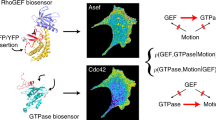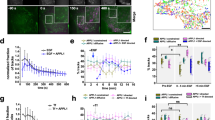Abstract
G proteins of the Ras family function as molecular switches in many signalling cascades1,2,3; however, little is known about where they become activated in living cells. Here we use FRET (fluorescent resonance energy transfer)-based sensors to report on the spatio-temporal images of growth-factor-induced activation of Ras and Rap1. Epidermal growth factor activated Ras at the peripheral plasma membrane and Rap1 at the intracellular perinuclear region of COS-1 cells. In PC12 cells, nerve growth factor-induced activation of Ras was initiated at the plasma membrane and transmitted to the whole cell body. After three hours, high Ras activity was observed at the extending neurites. By using the FRAP (fluorescence recovery after photobleaching) technique, we found that Ras at the neurites turned over rapidly; therefore, the sustained Ras activity at neurites was due to high GTP/GDP exchange rate and/or low GTPase activity, but not to the retention of the active Ras. These observations may resolve long-standing questions as to how Ras and Rap1 induce different cellular responses4 and how the signals for differentiation and survival are distinguished by neuronal cells5.
This is a preview of subscription content, access via your institution
Access options
Subscribe to this journal
Receive 51 print issues and online access
$199.00 per year
only $3.90 per issue
Buy this article
- Purchase on Springer Link
- Instant access to full article PDF
Prices may be subject to local taxes which are calculated during checkout



Similar content being viewed by others
References
Barbacid, M. ras genes. Annu. Rev. Biochem. 56, 779–827 (1987).
Lowy, D. R. & Willumsen, B. M. Function and regulation of ras. Annu. Rev. Biochem. 62, 851–891 (1993).
Schlessinger, J. & Bar-Sagi, D. Activation of ras and other signaling pathways by receptor tyrosine kinases. Cold Spring Harb. Symp. Quant. Biol. 59, 173–179 (1994).
Bos, J. L. All in the family? New insights and questions regarding interconnectivity of Ras, Rap1 and Ral. EMBO J. 17, 6776–6782 (1998).
Marshall, C. J. Specificity of receptor tyrosine kinase signaling: transient versus sustained extracellular signal-regulated kinase activation. Cell 80, 179–185 (1995).
Vojtek, A. B. & Der, C. J. Increasing complexity of the Ras signaling pathway. J. Biol. Chem. 273, 19925–19928 (1998).
Miyawaki, A. et al. Fluorescent indicators for Ca2+ based on green fluorescent proteins and calmodulin. Nature 388, 882–887 (1997).
Miyawaki, A. & Tsien, R. Y. Monitoring protein conformations and interactions by fluorescence resonance energy transfer. Methods Enzymol. 327, 472–500 (2000).
Scheffler, J. E. et al. Characterization of a 78-residue fragment of c-Raf-1 that comprises a minimal binding domain for the interaction with Ras-GTP. J. Biol. Chem. 269, 22340–22346 (1994).
Feig, L. A. & Cooper, G. M. Inhibition of NIH3T3 cell proliferation by a mutant ras protein with preferential affinity for GDP. Mol. Cell. Biol. 8, 3235–3243 (1988).
Rodriguez-Viciana, P. et al. Role of phosphoinositide 3-OH kinase in cell transformation and control of the actin cytoskeleton by Ras. Cell 89, 457–467 (1997).
Ichiba, T. et al. Activation of C3G guanine nucleotide exchange factor for Rap1 by phosphorylation of tyrosine 504. J. Biol. Chem. 274, 14376–14381 (1999).
Hoshino, M., Kawakita, M. & Hattori, S. Characterization of a factor that stimulates hydrolysis of GTP bound to ras gene product p21 (GTPase-activating protein) and correlation of its activity to cell density. Mol. Cell. Biol. 8, 4169–4173 (1988).
Zhang, Y., Moheban, D. B., Conway, B. R., Bhattacharyya, A., & Segal, R. A. Cell surface Trk receptors mediate NGF-induced survival while internalized receptors regulate NGF-induced differentiation. J. Neurosci. 20, 5671–5678 (2000).
Riccio, A., Pierchala, B. A., Ciarallo, C. L. & Ginty, D. D. An NGF-TrkA-mediated retrograde signal to transcription factor CREB in sympathetic neurons. Science 277, 1097–1100 (1997).
Xing, J., Kornhauser, J. M., Xia, Z., Thiele, E. A. & Greenberg, M. E. Nerve growth factor activates extracellular signal-regulated kinase and p38 mitogen-activated protein kinase pathways to stimulate CREB serine 133 phosphorylation. Mol. Cell Biol. 18, 1946–1955 (1998).
Kitayama, H., Sugimoto, Y., Matsuzaki, T., Ikawa, Y. & Noda, M. A ras-related gene with transformation suppressor activity. Cell 56, 77–84 (1989).
Cook, S. J., Rubinfeld, B., Albert, I. & McCormick, F. RapV12 antagonizes Ras-dependent activation of ERK1 and ERK2 by LPA and EGF in Rat-1 fibroblasts. EMBO J. 12, 3475–3485 (1993).
Hu, C. D. et al. Coassociation of Rap1A and Ha-Ras with Raf-1 N-terminal region interferes with Ras-dependent activation of Raf-1. J. Biol. Chem. 272, 11702–11705 (1997).
Mochizuki, N. et al. Activation of ERK/MAPK pathway by an isoform of rap1GAP associated with Gαi. Nature 400, 891–894 (1999).
Satoh, T., Nakafuku, M. & Kaziro, Y. Function of Ras as a molecular switch in signal transduction. J. Biol. Chem. 267, 24149–24152 (1992).
Niwa, H., Yamamura, K. & Miyazaki, J. Efficient selection for high-expression transfectants with a novel eukaryotic vector. Gene 108, 193–200 (1991).
Miyawaki, A., Griesbeck, O., Heim, R. & Tsien, R. Y. Dynamic and quantitative Ca2+ measurements using improved cameleons. Proc. Natl Acad. Sci. USA 96, 2135–2140 (1999).
Ohba, Y. et al. Rap2 as a slowly responding molecular switch in the Rap1 signaling cascade. Mol. Cell. Biol. 20, 6074–6083 (2000).
Lippincott-Schwartz, J. et al. Monitoring the dynamics and mobility of membrane proteins tagged with green fluorescent protein. Methods Cell Biol. 58, 261–281 (1999).
Acknowledgements
We thank D. Bowtell, K. Kaibuchi, J. Miyazaki, N. Minato and N. Nomura for plasmids; H. Mizuno, F. Ohba, N. Otsuka, K. Kimura and K. Okuda for technical assistance; and S. Hattori, M. Dutta and A. Dutta for the critical reading of the manuscript. Supported by grants from the Ministry of Health and Welfare, from the Ministry of Education, Science, Sports and Culture, Mitsui Life Social Welfare Foundation, the Princess Takamatsu Cancer Research Fund and from the Japan Health Science Foundation.
Author information
Authors and Affiliations
Supplementary information
Movie 1
EGF-induced Ras activation. COS-1 cells expressing Raichu-Ras were serum-starved and stimulated with EGF. Phase contrast (upper left), CFP (lower left), and YFP images (lower right) were obtained every 20 sec. The FRET image (upper right) was created from images of CFP and YFP. A series of images were saved as a stack file, which was converted to a video file.
Movie 2
EGF-induced activation of Ras and Rap1. See legend to Figure 2a. COS-1 cells transfected with pRaichu-Ras or pRaichu-Rap1 were serum-starved and stimulated with EGF. FRET image was obtained every 20 sec and a series of images were saved as a stack file, which was converted to a video file.
Movie 3
Effect of the dominant-negative H-Ras mutant and the active Rap1 mutant on EGF-induced Ras activation. COS-1 cells expressing Raichu-Ras with H-RasN17 (left) or Rap1V12 (right) were serum-starved and stimulated with EGF. FRET image was obtained every 20 sec and a series of images were saved as a stack file, which was converted to a video file.
Rights and permissions
About this article
Cite this article
Mochizuki, N., Yamashita, S., Kurokawa, K. et al. Spatio-temporal images of growth-factor-induced activation of Ras and Rap1. Nature 411, 1065–1068 (2001). https://doi.org/10.1038/35082594
Received:
Accepted:
Issue Date:
DOI: https://doi.org/10.1038/35082594
This article is cited by
-
Computer-based design of sensors that can monitor endogenous Ras activity
Nature Biotechnology (2024)
-
Effects of 5G-modulated 3.5 GHz radiofrequency field exposures on HSF1, RAS, ERK, and PML activation in live fibroblasts and keratinocytes cells
Scientific Reports (2023)
-
CD6-mediated inhibition of T cell activation via modulation of Ras
Cell Communication and Signaling (2022)
-
TGFβ-induced changes in membrane curvature influence Ras oncoprotein membrane localization
Scientific Reports (2022)
-
Quantification of FRET-induced angular displacement by monitoring sensitized acceptor anisotropy using a dim fluorescent donor
Nature Communications (2021)
Comments
By submitting a comment you agree to abide by our Terms and Community Guidelines. If you find something abusive or that does not comply with our terms or guidelines please flag it as inappropriate.



